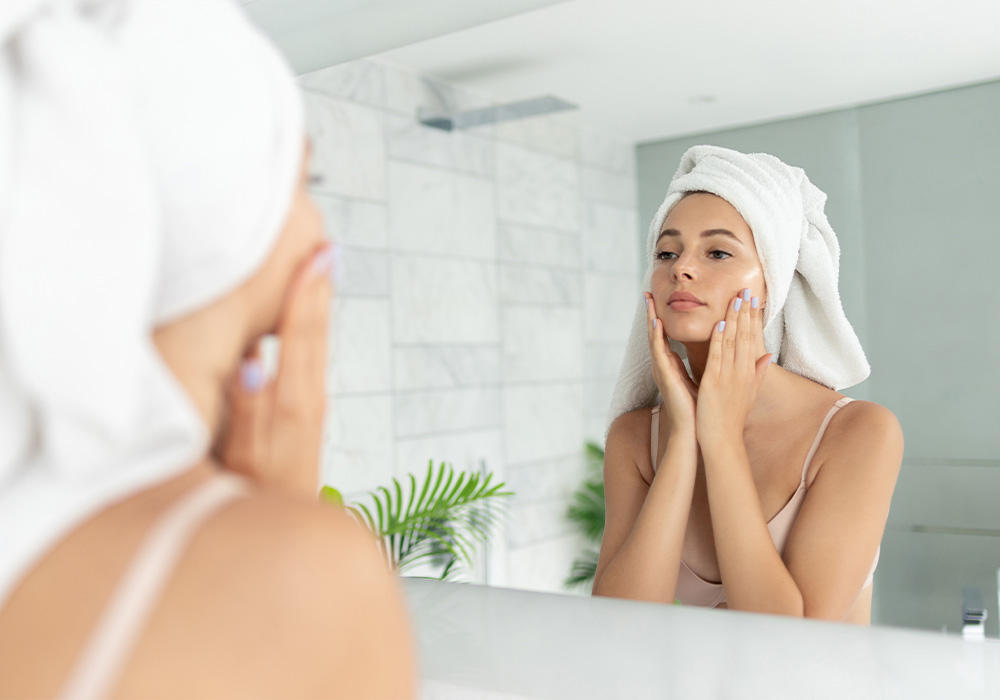
The dreaded retinol purge. For many of us, it’s inevitable that our skin will react this way after using retinol or retinoids for the first time. Or, maybe it’s not your first time, but you’re introducing a new or stronger formula into your routine. However, retinol isn’t called the gold standard anti-aging ingredient for no reason.
As we age, the rate at which our skin cells turnover naturally slows down. Retinol and retinoids, which are derived from vitamin A, are praised by dermatologists and other skin experts for their ability to speed up this cell turnover for healthier, youthful-looking skin. However, with this increase in skin “shedding,” it can cause purging to occur, which isn’t so fun. Here’s what retinol purging entails and how you can manage it.
Why Retinol and Retinoids Cause Skin to Purge
According to celebrity aesthetician Joshua Ross of SkinLab, it is common for the skin to purge when introducing a retinol. This is because the increased cell turnover is rapidly bringing breakouts to the surface in an effort to rid them from the skin. “It is important to note that these breakouts would have happened either way, just at a slower pace,” he explains.
By encouraging your body to produce new skin cells faster, old, dead skin cells are pushed up and off of the outer layer of skin. “This is what causes the dry, flaky effect you get when you use retinol,” says SkinSpirit aesthetic nurse practitioner Melanie Frye. “This same process can push up ‘skin trash’ or oil and debris that may be hiding under the surface. As this debris comes to the surface, you may experience a temporary increase in breakouts, or a ‘purge’ of this debris, which is very normal. People with oily skin tend to be more prone to purging. On the other hand, people with dry skin may experience more flaking and irritation.”
It’s important to note that retinol isn’t the only skin-care ingredient that can cause skin to purge. “Benzoyl peroxide, salicylic acid and glycolic acid can also trigger a purge period,” says New York dermatologist Elaine Kung, MD. “Allowing the skin to acclimate to these ingredients can prevent tumultuous purge periods.”
What does retinol purging look and feel like?
Dr. Kung uses the term “retinol uglies” to describe the period of retinol purging. “I tell patients who especially have comedones—whiteheads and blackheads—that they will experience a purge period. What is stuck under the skin will come up over the first few weeks of using a retinol or retinoid,” she says. “During the purging, there may be more ‘acne bumps’ coming to the surface, but after this phase, the skin will be smoother. There may also be more dryness or what resembles a rash.”
“The congestion comes to the surface of the skin, so purging may also appear as red bumps, cysts and/or pustules,” explains New York dermatologist Marisa Garshick, MD. “It’s important not to pick at or pop the pimples, as this can make the purging worse and lead to scarring.”
Frye adds that because the skin may be red and irritated as well, it may be difficult to tell the difference between a purge and a normal breakout. “A purge will occur shortly after you begin using retinol. However, a breakout in a new area or one that occurs during your cycle, with stress or after beginning a new non-retinol skin-care product, may not be purging,” she says. “These breakouts should be treated differently than purging.”
If purging is accompanied by irritation like redness, peeling and tenderness, Ross suggests reducing to the lowest percentage of retinol. This may be 0.025-percent, and then alternate using it every other night. “If after 30 days you are not seeing a reduction in sensitivities, you may want to discontinue using retinol altogether.”
If your skin doesn’t purge, does it mean your retinol isn’t strong enough?
“No,” says Dr. Kung. “Skin doesn’t have to purge for retinol to be effective. Also, retinol products have to be used for several months, if not years, to have true benefit for skin health. Therefore, not experiencing bumps or pink, peeling skin does not mean that the retinol is not working hard enough.”
Which products or ingredients should you use to calm and/or reduce the purging?
Frye recommends using a light, oil-free moisturizer. “Retinol can be very drying to the skin, so moisturizer can counterbalance the dryness and soothe any irritation from the product,” she says. “Additionally, using a gentle, non-exfoliating cleanser can help soothe the skin. And one of the top skin-care tips is to always incorporate a good physical sunblock. Look for the ingredients zinc and titanium dioxide to protect purging skin from the negative impacts of sun exposure.” Sun exposure has a negative impact on just about everything when it comes to our skin.
Some brands pair their retinol products with a complementary moisturizer to take the guesswork out of the process and keep skin happy. We like Mary Kay’s Clinical Solutions Retinol 0.5 Set ($120), a nighttime retinol serum and a calming facial milk. It comes with clear-cut directions for how to build up your retinol usage over the course of nine weeks and beyond.
“It can also help to look for a nourishing moisturizer that is non-comedogenic, meaning it won’t clog your pores,” advises La Jolla, CA dermatologist Azadeh Shirazi, MD. “My favorite is Intense Recovery Complex, which I put all of my patients who are starting retinoids or exfoliants on because it has a light hydrating texture formulated to support and repair the skin barrier. Ingredients such as ceramides, phytosphingosine lipids and glycerin strengthen the skin barrier and hydrate the skin. Allantoin calms skin inflammation.”
Some of Dr. Garshick’s favorites for skin-calming and barrier repair include Vanicream Gentle Facial Cleanser and La Roche-Posay Double Repair Moisturizer. “If your skin feels particularly sensitive, it can help to use a micellar water, such as Simple Skincare Micellar Water, or a calming serum like Vichy Mineral 89 Prebiotic Recovery and Defense Concentrate.”
How long does skin purging last after using retinol?
According to Frye, skin purging from retinol usually lasts two weeks. But in some cases, it can last up to six weeks. “Skin cycles last 28 to 30 days, so sometimes it takes a full skin cycle for you to adjust. You should see a licensed aesthetician or dermatologist if the issue persists longer or becomes troublesome in other ways. If you continue to use the products, your skin will begin to improve. The newly stimulated skin cell turnover yields improvements in reducing future breakouts. It also improves wrinkles, texture and fine lines, as well as pigmentation from previous breakouts and sun exposure.”
Dr. Garshick adds, “When incorporating any new skin-care product, it is best to wait two to three months to see results. It can take time for your skin to get adjusted to the product and for the benefits to appear.”
Is there any way to avoid purging from retinol products entirely?
Not entirely, but Dr. Kung says easing into your retinol can help reduce purging. “I often encourage my patients to ease into retinol use. This means ‘get your skin acclimated to the ingredient slowly,’” she explains. “Use a pea-size amount of retinol cream or serum every two to three nights, instead of plunging into every night. Slowly introducing the ingredient can help prevent the rashy-type and bumpy-type of retinol uglies.”
“When it comes to retinol application, you can also use moisturizers before and after applying retinol,” adds Dr. Shirazi. “This is called the sandwich method, to reduce the intensity of the retinol.” We also like brands that allow you to level up your retinol as your skin adjusts. Fig.1 has a three-step retinol system so you can graduate to a higher concentration whenever your skin is ready.”






